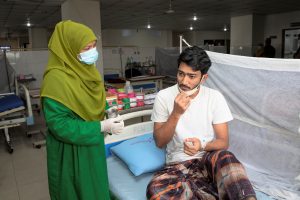Medication Without Harm: Implementing Pharmacovigilance
By Alemayehu Duga, Andualem Oumer, and Kate Kikule, USAID MTaPS
Across the world, people take medicines to prevent diseases and improve their health conditions. Unfortunately, unsafe medicines and medical practices and medication errors are leading causes of injury and avoidable harm in health care systems around the world. Globally, medication-related harm accounts for 50% of preventable harm in medical care, estimated to cost USD 42 billion in global health expenditure according to the World Health Organization (WHO). The 2022 Patient Safety Day theme, Medication Without Harm, aims to promote safe medication practices to prevent medication errors and reduce medication-related harm.
As health care systems across the globe are facing complex challenges, including COVID-19, antimicrobial resistance, and distribution of low quality and substandard medicines, a focus on increasing patient safety will be of utmost importance in shaping the next generation of medical interventions for emergent and common diseases to achieve the health outcomes we want to see.
Treatment should not worsen a patient’s suffering: What is MTaPS doing?
Using medicines appropriately is crucial for safe and effective health care, but it is not without risk. For many patients, the side effects of their medicines and treatments can be more severe than their original conditions. When a patient has a serious side effect from a medicine, there are many questions and uncertainties that need to be addressed by the patient, their health care providers, and most importantly, by the health care system.
To minimize potential risks associated with the medication, one of the most effective approaches is a well-functioning pharmacovigilance system that involves patients or their caregivers reporting any problems they have experienced while taking a medicine. This information is used to improve the safety of the medicine for both current and future patients. Health care providers also play a critical role in detecting, managing, and reporting any incidents related to medicine use. Institutionally, medication harm can be minimized if the regulatory system is able to effectively fulfill its function of ensuring the safety, quality, and efficacy of medicines on the market. However, fewer than 30% of the world’s medicines regulatory authorities are considered to have the capacity to perform the functions required to ensure that medicines, vaccines, and other health products are safe and effective and do not harm patients.
To bridge this critical gap in health systems for ensuring patient safety, USAID is working through its Medicines, Technologies, and Pharmaceutical Services (MTaPS) Program to advance pharmacovigilance in countries and across borders in collaboration with national, regional, and global partners.
Strengthening national regulatory systems
MTaPS has been supporting countries to build or strengthen their pharmacovigilance systems through regulatory capacity enhancement and pharmaceutical-sector governance to protect the public from substandard and falsified products. The program champions WHO’s Global Benchmarking Tool (GBT) as a global metric to measure the functionality of national regulatory authorities and has been implementing it in Bangladesh, Mozambique, Nepal, and Rwanda to equip their national regulatory authorities with the necessary laws, regulations, policies, standard operating procedures, and human and institutional capacity to adequately manage pharmaceutical regulatory systems and services, including for pharmacovigilance.

A patient receiving medication from a health provider at a hospital, Dhaka. Photo credit: Yousuf Tushar for MTaPS
Enabling safe introduction of new treatments for diseases
Monitoring patients who are taking a new medicine, especially for high-risk treatments, is critical for patient safety and the successful introduction of new innovations in treatment. MTaPS is working with Mozambique’s national HIV program and its Directorate of Pharmacy to monitor adverse drug reactions or previously undocumented reactions to dolutegravir-based antiretroviral medicines, which were introduced in the country in 2018 in a phased manner. The implementation of PViMS, a web-based pharmacovigilance tool for monitoring medicine safety, is enabling timely tracking, reporting, and assessment of adverse events for responsive action, thus promoting patient safety. Similarly, in the Philippines, MTaPS is working with its Food and Drug Administration to help revise the National Policy and Program on Pharmacovigilance so that new treatments for HIV/AIDS and drug-resistant TB can be monitored for patient safety.
Surveilling vaccine safety
COVID-19 created a new urgency for ensuring patient safety, including the need for vaccine pharmacovigilance to detect, respond to, and prevent adverse events following immunization (AEFI). In Mali, the mass immunization program relied on a wide swath of actors from various sectors, including universities, private-sector facilities, the pharmacovigilance experts committee, and central government institutions trained on AEFI reporting and cause analysis with help from MTaPS to safely and confidently administer COVID-19 vaccines to the population. In Bangladesh, MTaPS worked closely with local partners and WHO to develop an online AEFI reporting system, trained health care workers, and widely distributed informative and educational materials to health care professionals and the public, all of which led to robust reporting of AEFIs for appropriate action.
Regionally harmonizing regulatory systems
Regionally harmonizing medicine regulatory systems can standardize processes and guidelines across countries and bolster the regulatory capacity of a region for critical regulatory functions such as drug safety surveillance. The West African Health Organization of the Economic Community of West African States or ECOWAS is working toward greater patient safety in the region through a shared online portal for its 15 member countries, launched with support from MTaPS, to monitor and report adverse reactions to medicines and vaccines.
Making Patient Safety a Priority for Quality Health Care
The COVID-19 pandemic has spotlighted weak systems in countries for monitoring the safety of medicines and vaccines. Embedding pharmacovigilance in health care systems is a much needed investment to protect patients from adverse effects and potential severe harm from medicines and vaccines so they can enjoy quality health care delivery that ensures their safety and helps improve treatment outcomes.